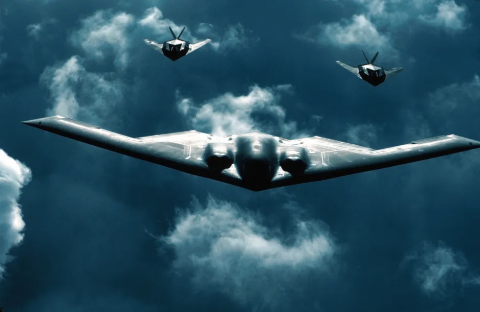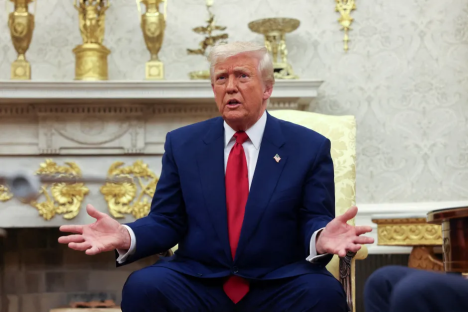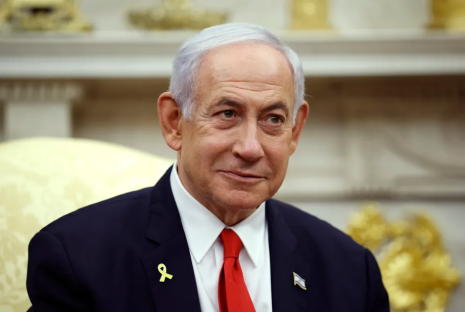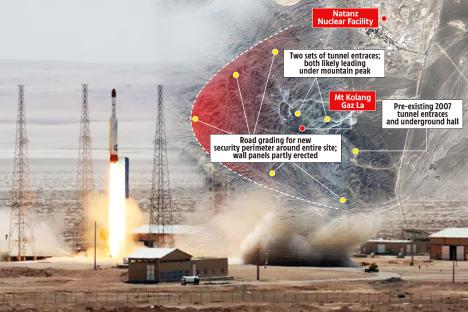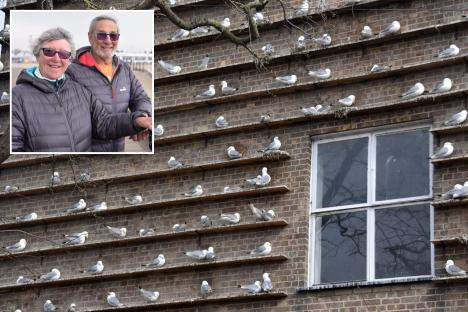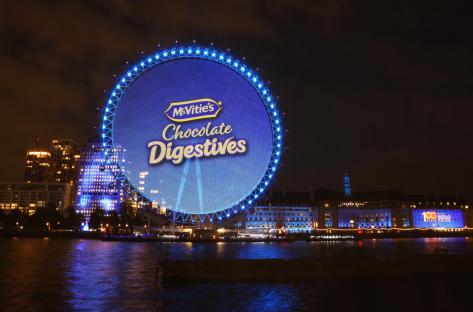IRAN has been found building a ring of steel protection around its most important nuclear facility amid threats of blitzing airstrikes by the US and Israel.
Supreme Leader Ayatollah Ali Khamenei is scrambling to brace for impact after President Donald Trumpthreatened to bomb the regime“like never before”.
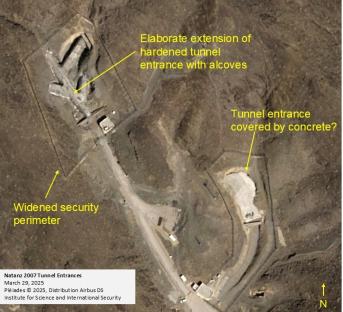
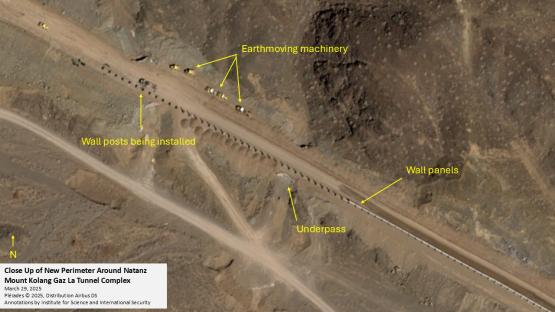
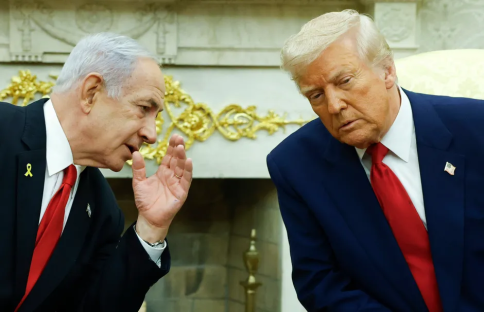
Iran is beefing up two deeply buried tunnel complexes – linked to its main nuclear complex – with a massive security perimeter.
Commercial satellite imagery shows defence construction around the base of Mt Kolang Gaz La, located south of the Natanz enrichment complex.
The satellite images, taken on March 29, showed hardened entrances to the complexes, high wall panels erected along the verges of a graded road encircling the mountain peak, and excavations for the installation of more panels.
And the north side of the perimeter joins the Natanz plant security ring, according to a report published by the Institute for Science and International Security (ISIS).
The multi-peaked mountain contains a new, large, deeply buried tunnel complex and a separate, smaller one dating back to 2007, which was previously partly destroyed.
Tehran has barred access to the tunnels to inspectors of the UN International Atomic Energy Agency (IAEA) who are monitoring its nuclear program.
And that suggests that Iran is increasingly worried about foreign surveillance of its nuclear production sites, which the regime claims are just for civilian use.
David Albright, the institute president, said the new perimeter suggested that the tunnel complexes – under construction beneath Mount Kolang Gaz La for several years, could become operational relatively soon.
This has raised concerns that they could be used to store Iran's stockpile of highly enriched uranium or undeclared nuclear materials, and advanced centrifuges that could quickly purify enough uranium for a bomb, Albright added.
IAEA Director General Raphael Grossi said yesterday: “It is obvious that this is a place with numerous and important activities [on Iran's nuclear program].
“It's a bit of a ping pong, but the digging continues, the building continues.”
Iran's move to secure its nuclear site comes after the Israeli and American military reportedly planned to strike the Iranian regime and wipe out its nuclear sites in just weeks.
Benjamin Netanyahu is said to have held high-profile talks with President Donald Trump to launch a with the help of US fighter jets.
Sources in in a coordinated effort with the US if Tehran fails to thrash out a nuke deal.
The coordinated strike, which included both ground offensive as well as aerial attacks, was planned for as early as May, it was revealed.
Plans were to launch a campaign of Israeli commando raids on underground nuclear sites, along with bombing using US fighter jets.
A report published by The New York Times outlines how the US was preparing to assist Israel in its military offensive against Iran.
The US began moving loads of military equipment in the Middle East, along with a second aircraft carrier Carl Vinson to join the already-stationed Harry S. Truman in the Red Sea.
Two Patriot missile batteries and a Terminal High Altitude Area Defence system (THAAD) were also shipped to the Middle East.
Around a half-dozen B-2 bombers capable of carrying 30,000-pound bombs essential to destroying Iran’s underground nuclear program were dispatched to Diego Garcia, an island base in the Indian Ocean.
Moving additional fighter aircraft to the region, potentially to a base in Israel, was also considered, according to the report.
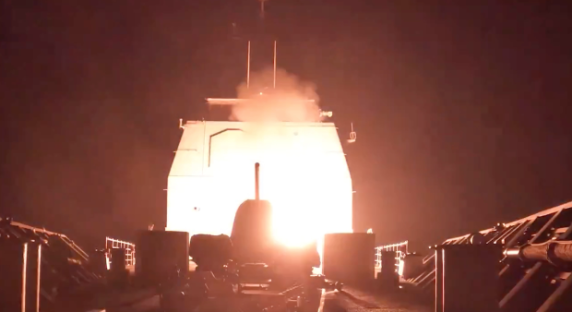
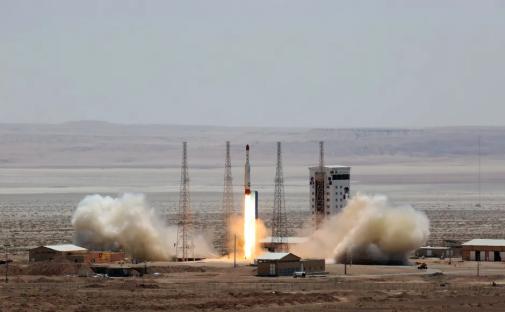
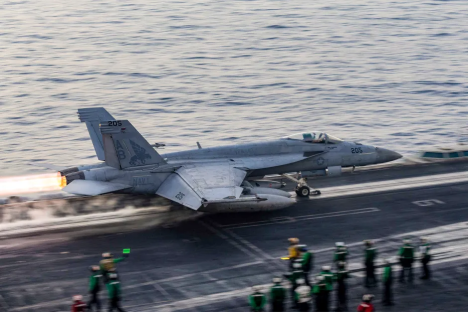
It came at a time whenin Yemen.
Most of these US military equipment in the Middle East could well be used to cripple the Iranian-proxy terrior group in the region, who have been attacking US vessels in the Red Sea.
But US officials revealed that the weaponry was also part of the planning for potentially supporting Israel in a conflict with Iran.
Israel had reasons to believe that the US would help it out to attack Iran after .
The president blasted: “Any further attack or retaliation by the Houthis will be met with great force, and there is no guarantee that that force will stop there.
“Iran has played ‘the innocent victim' of rogue terrorists from which they’ve lost control, but they haven’t lost control.”
Trump also vowed to and strike up a new nuclear deal with the US within months.
However, Trump chose to explore the path of diplomacy before giving a green light to the potential Iran blitz amid the rising threat.
He told Netanyahu that he would not support an Israeli attack in May while the US was still at the negotiating table with Iran.
Although senior US officials have suggested that the US could support an Israeli plan to attack Iran if the talks fail.
Just days ago, the US and Iran finished their first round ofto discuss a new nuclear agreement for the Iranian regime.
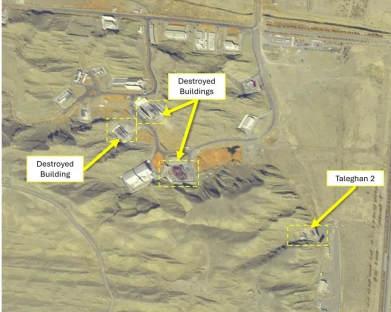
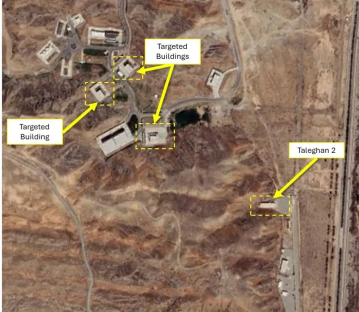
Defying expectations of a fiery confrontation, their meeting in Oman was instead held “in a constructive atmosphere”, according to Iran's Foreign Ministry.
The Middle Eastern country also said that after two-and-a-half hours of indirect talks, Iranian diplomat Abbas Aragchi and Trump envoy Steve Witkoff actually spoke directly.
They added that discussions would continue in coming weeks.
Meanwhile, Secretary of State Marco Rubio said in an interview released Wednesday that Iran must give up all nuclear enrichment if it wants to make a deal during talks with the Trump administration and head off the threat of armed conflict.
Iran insists its nuclear program is for civilian energy use and says it does not seek to make weapons-grade uranium to build atomic bombs.
Rubio said: “If Iran wants a civil nuclear program, they can have one just like many other countries can have one, and that is they import enriched material, Rubio said in a podcast interview with journalist Bari Weiss.
“But Iran has long refused to give up its ability to enrich uranium. President Donald Trump in his first term pulled the U.S. out of a Obama-era nuclear deal focused on monitoring to ensure Iran did not move toward weapons-grade enrichment.”
War footing
Meanwhile, reports also emerged revealing Tehran's preparation for a potential US strike.
Iran is said to be readying itself by setting up missiles with the capability to strike US positions, The Tehran Times revealed.
A significant number of these weapons are located in underground facilities scattered across the country, designed to withstand airstrikes.
Khamenei is also reportedly amassing troops to brace for potential US airstrikes after Trump threatened to bomb the regime “like never before”.
One senior Iranian military official said that the regime's decision to ditch its support for the Houthis was made to prepare for a direct conflict with the US, according to The Telegraph.
The source said that Tehran wants to focus more on the threat from Donald Trump rather than spending its resources on its proxy network in the Middle East.
They said: “The view here is that the Houthis will not be able to survive and are living their final months or even days, so there is no point in keeping them on our list.
“They were part of a chain that relied on Nasrallah [the former secretary-general of Hezbollah] and Assad, and keeping only one part of that chain for the future makes no sense.
“Tehran’s primary concern is Trump and how to deal with him.”
“Every meeting is dominated by discussions about him, and none of the regional groups we previously supported are being discussed.”
